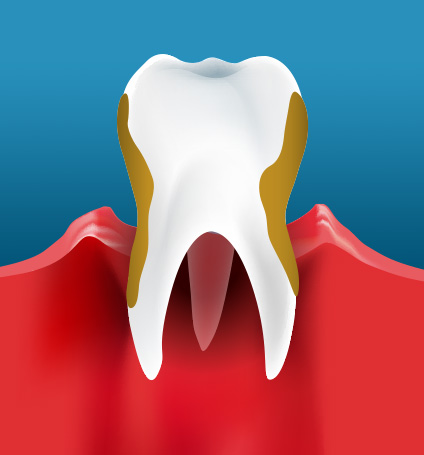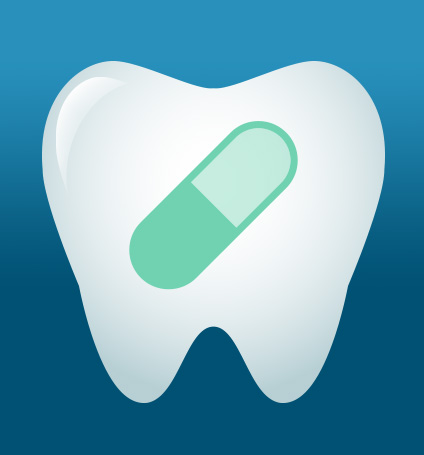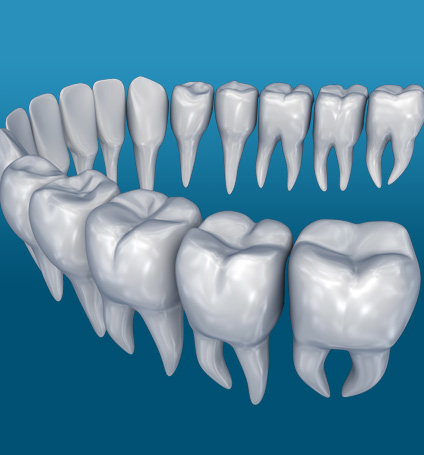PERIODONTICS
PERIODONTICS

Periodontal Disease
Periodontal or gum disease is an infection of the tissues that surround and support your teeth. It is a leading cause of tooth loss in American adults. Gum disease is caused by plaque, which is the sticky film of bacteria that is brushed and flossed away with regular, proper oral care. However, when plaque is left on the teeth, plaque then produces toxins that attack below the gum line in the sulcus, a shallow v-shaped crevice between the tooth and gums. This causes the bond between teeth and gums to break down. In the early stage of gum disease (gingivitis), gums may become red and swollen and bleed easily. In the more advanced stage (periodontal disease), teeth can loosen and fall out. Because damage can occur below the gum line, if no symptoms are evident, it can be a condition that is not addressed until it is too late. Good oral hygiene and regular dental examinations are essential in the prevention and early detection of gum disease especially since you can have it without experiencing any warning signs.
Gum disease has also been linked to many health problems. It is proven science that our teeth can affect our heart health, and poor gum health can lead to a heart attack event. What can happen is the bacteria on our teeth that are the contributing factor to gum disease, can enter the bloodstream very easily and attach to any existing fatty deposits in the arteries. This causes the artery to become clogged at a more accelerated rate than that of someone who may be experiencing dental health in better condition. When the arteries become clogged, this can lead to a heart attack.
Due to the link between gum and heart disease, more studies are being done to address the link between gum disease and strokes. Much like the process that can occur with gum disease and heart attacks, if a great amount of bacteria enters the bloodstream consistently over time, this can lead to a blocked blood vessel resulting in a stroke.
Patients with diabetes may also find that keeping their their blood sugar levels balanced may be more difficult is the individual is suffering from gum disease. One affects the other in case, such as if a patient is struggling to take measures to control their diabetes, and sugar in the body is elevated, the bacteria on gums thrives on the elevated sugar in the body.
Good measures to take aside from regularly scheduled visits to your dental office and regimented dental health actions taken daily, are elements such a diet, exercise, and limiting the use of tobacco products and alcoholic beverages. The right nutrition helps the body to fight off infection, and curbing tobacco and alcohol products helps to to reduce the chance of bacteria experiencing the perfect environment to flourish.
Signs that you may have gum disease include:
- Gums that are red, swollen, tender, bleed easily or pull away from the teeth
- Persistent bad breath or bad taste
- Loose or separating teeth
- A change in the way your teeth fit together
- A change in the fit of partial dentures

Arestin®
The dental advancements of today include the use of antibiotics to reduce the severity and prevalence of gum disease. Arestin® is just such an antibiotic treatment that fights periodontal disease used during scaling and root planing (SRP) procedures. Arestin® is inserted in powder form into infected areas of the gums to treat any areas that SRP may have missed. SRP used with Arestin® is proven to be more effective than SRP performed alone. A powerful advantage of Arestin® is that the administration of it continues to work effectively beyond the initial visit to your dental office. The composition of the drug is microspheres, and these microspheres gradually release the antibiotic over time, for sustained results and success.

Laser Gum Treatment
Laser gum treatment is great option in the treatment of gum issues. Laser gum treatment is a noninvasive and painless procedure that can treat a wide range of gum conditions with advanced laser technology. This is a safe and affordable treatment that can be used to treat gum disease, repair deep gum pockets, address sore gums and tooth damage, and even improve a gummy smile.
During laser gum treatment, no damage or changes are made to healthy teeth and gums. The laser is aimed directly at the targeted area without cutting any gum tissue and seals the area as it treats. There is no need for stitches and minimal risk of infection or bleeding with this conservative yet effective treatment. Most patients report less overall swelling and discomfort.

Bone Grafts
If necessary, bone can be removed from one area and replaced, or grafted, into another area to correct cosmetic or functional defects in the mouth, or to aid in the placement of dental implants. One or more types of bone graft may be recommended depending on the patient’s condition.
- In a sinus lift, bone is grafted to the bottom of the sinus so that a dental implant may be placed in the upper back jaw.
- Ridge augmentation replaces bone in the oral ridge that has been absorbed by the body.
- Nerve repositioning procedures move the inferior alveolar nerve (the nerve that gives us feeling in our lower lip and chin) before placement of dental implants in the lower jaw.
Bone for a graft is often taken from within the mouth while preparing for the implant placement. The bone may also be taken from the chin, third molar (wisdom tooth) region, or upper jaw. For more extensive procedures, the hip or knee may serve as donor sites. Although bone is usually taken from the patient’s own body, alternate sources may be recommended such as synthetic bone material.

Tooth Extraction
Tooth extraction is recommended when a tooth becomes loose from gum disease, when teeth are crowded, when one tooth is preventing another from erupting, or when a tooth is so damaged or decayed that root canal therapy would be ineffective.
Because missing teeth can cause health problems ranging from tooth shifting to difficulty chewing, restorative procedures are recommended following extraction. These may take the form of dental implants, bridges or dentures.
The procedure itself may require removal of soft or hard tissue, depending on whether the tooth is fully erupted. A local anesthetic is usually all that is needed to eliminate discomfort, although general anesthetic may be used for sensitive patients or children.

